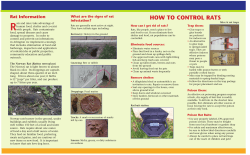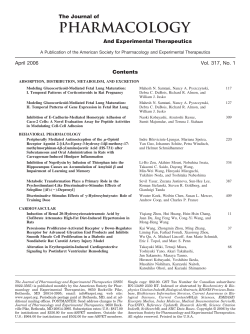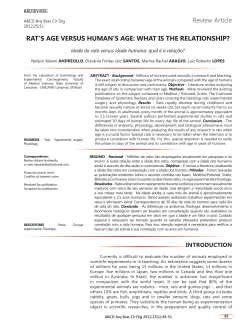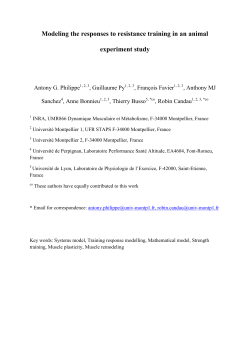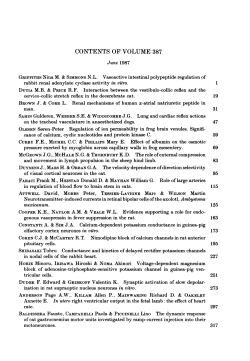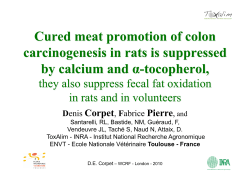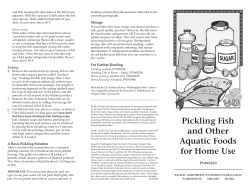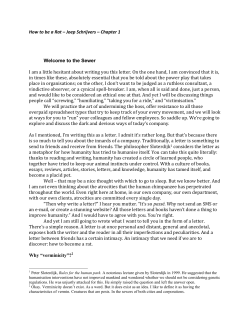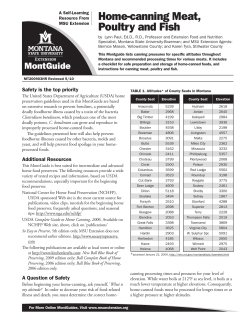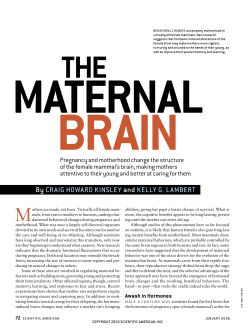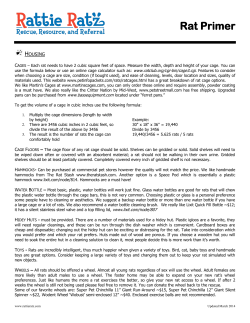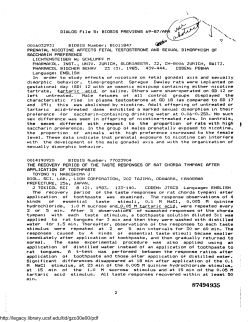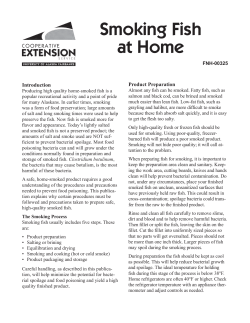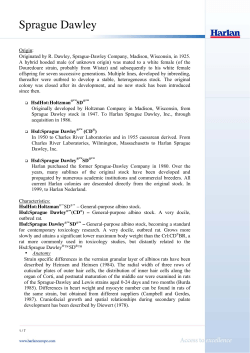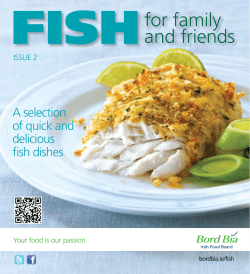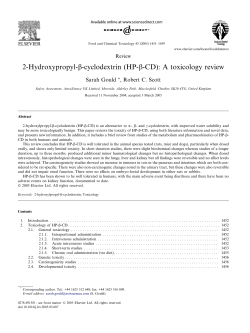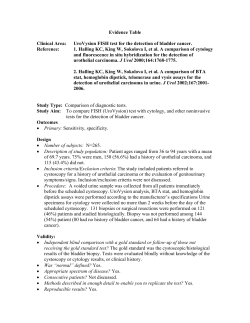
Document 8221
U D K 5 9 9 . 3 2 3 . 4 : 6 3 7 . S 0/ 8' 831
Originalresearchpaper
EVALUATION OF THE POTENTIAL ANTTARRHYTHMIG EFFECT OF
FISH MEAT DURING MYOGARDIAL ISGHEMIA.REPERFUSION
!P ft1ATS
NikolettMorvayl,JuditPeter-Sz[icsn62,
LjiljanaM. Kostadinovic3,
OliveraM. Duragic3,
BojanaM. Kokict,lstvanCsengerio,lstvanLepranl.
lDepartment
Facultyof Medicine,University
of Pharmacology,
of Szeged,Hungary
2lnstitute Animal
Facultyof Agriculture,
of
SciencesandWildlifeManagement,
University
of Szeged,Hungary
3University
of Novi Sad, Instituteof FoodTechnology,NoviSad, Serbia
oResearch
(HAKI)Szarvas,Hungary
Aquaculture
Institute
for Fisheries,
and lrrigation
r
"Corresponding
author:
E-maiI address:lepran.istvan@med.
u-szeged.hu
ABSTRACT:The potentialantiarrhyihmiceffectof dietaryfish meat feedingwas investigatedin rats.
Fish meat,harvestedfrom carpsfed experimental
foods enrichedwith essentialfatty acids,was mixed
rat food and fed to ratsfor 4 weeks.At the end of the feedingperiodin anesthetized
with a comrnercial
inducedarrhythmiaswere inducedby occlusionof the coronary
rats myocardialischemia-reperfusion
fatty
arteryfor 6 min, followedby repertusion.Supplyingfish meat, rich in n-3 type polyunsaturated
inducedarrhythmias
acids,significantly
decreasedthe incidenceof myocardialischemia-reperfusion
that feeding
in the rat, and increasedthe survivalrate. These resultsconfirmpreviousinvestigations
fish oil or fish meat may offer cardioprotective
effect,and consumptionof the farmed fish, like carp,
may resultin similarprotectiveeffectsto the marinefood.
Key words: rafs, myocardialischemia-reperfusion,
fishmeat diet, cardioprotection
INTRODUGTION
diseasesare the leading
Cardiovascular
cause of death both in developed and
d e v e l o p i n gc o u n t r i e s( W H O , 2 0 0 8 ) . l n
most cases ischemicheart disease,acute
myocardialinfarctionand associatedventricular arrhythmiasstand in the background. The restorationof blood flow is
commonlyused therapyin case of acute
myocardial infarction. Early repertusion
after a short lastingmyocardialischemia,
however,can result in arrhythmias,tissue
injury and cell death, called reperfusion
injuryffellon and Hausenloy,2007).
emphasizethe imSeveralinvestigations
portanceof n-3 polyunsaturated
fatty acid
(PUFA) consumptionand its cardioprotectiveeffects(Psotaet al., 2006), both in
primaryand secondarypreventionof cardiovascularcomplications(Saravananet
aI.,2010).Thesehumanstudiesaboutthe
beneficial effects of PUFA feeding are
supportedby in viva investigationsin rats
(Lepr6rnet al., 1981; Mclennanet al.,
1990;Leprdnand Szekeres,1992;Zhu et
al., 1994;Fdldeset al,, 2006),marmosets
(Charnock,1994) and dogs (Oskarsson,
1993).Long chainn-3 PUFA has also triglyceride lowering effect, and decrease
the synthesisof inflammatoryeicosanoids
and cytokines(reviewedby Calder,2AA4).
The human body cannotsynthesizethese
essentialfatty acids,thus we need to take
with consumingfood rich in PUFA.Marine
and dofoodstuff,rich in eicosapentaenoic
source
main
acids, is the
cosahexaenoic
71
NikolettMorvayef ai., Evaluationof the potentialantiarrhythmic
effectof fish meat duringmyocardialischemia-reperfusion
in
rats,Foodand Feed Research40 (2),71-76,2013
of n-3 fatty acids for human beings. However there are many continentalcountries without the opportunityto consume
fresh marine food, thereby people suggested to eat farmed fish more, e.g. the
carp.The aim of the presentinvestigations
was to study the effects of feeding carp
meat, harvested from fishes after using
different fish food composition,on myocardialischaemia-reperfusion
inducedarrhythmiasin rats.
EXPERIMENTAL
Animals and diet
The experimentswere performedon male
Sprague-Dawley rats weighing between
250-300 g. The animalswere housed5 to
a cage, and fed carp meat enrichedchow
as follows.All carp-meat enrichedrat food
(RF2,RF3, RF4, RFs) was preparedusing
frozen fish filletsmixed with corn flake in a
ratio of 3:1 of fish meat and corn flake.
This fillet mixture was then grinded and
pelleted after mixing with commercialrat
chaw ingredients.Rat food RF1 was prepared by using commercialfish meal with
added lard to equalize the energy contents.The final experimentalrat diets containedapproximately
10%of fish flesh.
Fish flesh used for preparing rat food
(RF2-RFS)was taken from carps, fed on
"experimentalextruded expanded foods
(carp food, CF2-CF5), enrichedwith different oils (linseedoil; fish oil and Mortierella
alpineoil, containing40% arachidonicacid
(ARA))or eicosapentaenoic
(EPA)and docosahexaenoic(DHA) ethyl esters. The
amountsof the addedoils were as follows:
CF2:6.4% Linseedoil (LSO);CF3:3.5%
i
Ij
LSO + 1.5%Arachidonic
acid(ARA)+ 1%
D H A ; C F 4 .6 , 0 % F i s ho i l ( F O ) ;C F 5 :4 . 5 %
FO + 1.5%ARA. Detaileddata of fish food
analysisand other observationsobtained
duringthe fish feedingexperiments
will be
presentedelsewhere.
The weeklyportionsof the rat foods were
sealedundervacuumin plasticbags and
stored in frozenform until use. The control
rats (CF) were fed a standard rat chow
(CRLT/Nrodentfood, Bonafarm,Babolna,
Hungary;containing20.0%crudeprotein,
4.4% crude fat and 4.3% crude fiber),
supplemented
with 10 weight%of porkfat,
rich in saturatedfatty acids. Rats were fed
for 4 weeks with the experimentaldiets.
Duringthistimethe animalsallowedto eat
the experimentalfood and to drink tap
water ad libitum.The rat experimentswere
pedormed accordingto the protocolreviewed by the EthicalCommitteefor the
Protectionof Animals in Researchof the
Universityof Szeged,Hungary.
Composition of the rat foods
Proximatecompositionand metabolizable
energy contents of the experimentalrat
foods,RF1 to RFs, as determinedby standard laboratorymethods (AOAC, 2005),
are presentedin Tabie 1.
Biological assessment of modified fish
meat in rats
Blood samples were taken for the
measurementof plasmatriglyceride(TG),
total cholesterol(TC), high density lipoprotein(HDL) and low densitylipoprotein
(LDL) cholesterolusing commerciallaboratory tests (Roche Diagnostics,Switzerland).
T a b l e1 .
Proximatecomposilion(gikg)and metabolizable
energycontentof the rat foods
Rat foods
Connposition
RF1
RF2
RF3
RF4
Dry rnatter
876
B6B
870
874
Crudeprotein
234
244
241
233
Crude fat
55
62
54
52
Crudefiber
31
34
36
35
Crudeash
73
68
65
65
N-free extract
483
460
474
489
Starch
264
291
286
310
ME (MJ/kg)
16.0
16.2
16.1
16.0
I
,l
;l
72
RF5
877
238
60
32
64
483
321
16.3
NikolettMoruayef a/., Evaluationof the potentialantiarrhythmiceffect of fish meat during myocardialischemia-reperfusion
in
rats, Food and Feed Research40 tZ\,71-76, 2O1Z
Myocardial ischemia-reperfusion induced arrhythmias in anesthetizedrats
arrhythmiascore was used, includingthe
incidenceand durationof differentarrhythmias by giving a grade to each animal
(Lepranand Szekeres,1992).
Animals were anaesthetizedwith pentobarbitoneand the left carotid artery was
cannulated for measuring the blood
pressure.The tracheawas cannulatedfor
artificial ventilation (Harvar:d Ventilator,
Model 603) and the chest was opened in
the fourth intercostalspace.The heartwas
exposed and a loose loop of atraumatic
silk was placed around the left main
coronaryartery,approximately2 mm from
its origin. Both ends of the ligaturewere
led out of the thoracic cavity through flexible tubing(Lepranand Szekeres,1992).
The standard electrocardiogram
(lead ll,
ECG) and the changesin blood pressure
were recordedcontinuouslyand displayed
after A/D conversion (Chart5, ADlnstruments, United Kingdom).After finishing
the preparationthe animalswere allowed
to stabilizef or 10 min, then the loose loop
of the coronaryartery ligaturewas tightened and fixed by clampingon the silk and
thus regional myocardial ischemia was
produdedfor 6 min and then followedby
reperfusion.
Statistical analysis
The survivalrate was coinparedby using
the Xz-methodwith Yates-correction.All
other parameters were expressed as
mean + standarderror of the mean (SE)
and after analysisof variancewere compared by means of the modified 't'-statisticalmethod.
RESULTS AND DISCUSSION
The consumptionof the amountof expe-'
rimental rat food was not diffe;ent from
that of the controlrat food. The final body
weight of the animalsafter 4-week dietary
period was not different among the different experimentalgroups. The plasma
triglyceride,total cholesterol,high density
lipoproteincholesteroland the low density
lipoproteincholesterolconcentrations
were
also not significantlydifferentafterfeeding
different experimentaldiets in rats. The
baseline heart rate and blood pressure
also did not differamongthe experimental
groupsstudied(datanot shown).
Coronaryarteryocclusionin rats pr:oduced
a slowly developingregional myocardial
ischemiathat inducedvariousarrhythmias
within 4-5 min (Table 2). There were no
significantdifferencesin the survivalrate,
incidenceof arrhythmiasduring myocardial ischemiain differentdiet fed groups,
as comparedto the control.
The survival rate and the incidence of
arrhythmiaswere analysedin accordance
with the Lambeth Conventions(Walker,
,. 1.988),i.e. ventricularfibrillation(VF), ventriculartachycai'dia(VT) and other types of
arrhythmias,includingsingleextrasystoles
(VEB), bigeminia,and salvos.The duration of VF, VT and other types of arrhythmia attacks were also measured. An
T able 2.
Survival rate and the incidence of arrhythmias durinq 6 min myocardial ischemia in anesthetized rats
Group
cF
R F1
R F2
RF3
RF*4_ " _
RFs
Survived
16
15
15
'13
15
14
In c i d ence of i schemi a i nduced arrhythmi as
None
VF
VT
Other
15
19
94
3
1173533427853853
1280853427640426
15
12
92
2
1510053300746960
tbo
5
36
14
1
6
8
50
1275
1
B
I
69
6
46
1
T
T
50
9
64
Score
1.7510.36
2.1310.65
1.6710.64
1,62+0.42
1.20x0.26
1.0010.30
N = total numberof animalsin a given grq_up;
n = numberof animalsshowingthe given response.None = no
arrhythmiaoccurred;VF = ventricularfibrillation;
VT = ventriculartachycardia;Other= othertypesof arrhythmias,
includingventricularextrasystoles,
bigeminia.
73
in
effectof fish meat duringmyocardialischemia-reperfusion
NikolettMorvayet al., Evaluationof the potentialantiarrhythmic
rats,Foodand FeedResearch40 (2),71-76,2013
Table 3.
Survivalrate and the incidenceof arrhythmiasduringreperfusionafter6 min myocardialischemiain
rats
anesthetized
Incidenceof reperfusioninduced arrhythmias
Score
Group
Survived
None
VF
VT
Other
o/
to
%
CF
RF1
RF2
RF3
RF4
RF5
15
5
33
11982*2
12975
127581
15
5
33
148570
0
1
1
0
18
B
8
7
0
o/
to
13
4
7
B
13
9
87
36*
58
67
87
64
%
15
7
B
11
13
14
100
64*
67*
92
87
100
%
11
6
10
7
B
12
73
55
83
58
53
86
5,40t0.27
3.09+0.62.
3.92t0.57*
4.17t0,61
5.1310.46
4.43l.0.47
For abbreviations
see Table2. Asteriskdenotesstatistically
significant
differencecomparedto the controlrat food
( CF )f ed an i m a l s(P< 0 .0 5 )
Reperfusionafter 6 min myocardialischemia inducedrapidlydeveloping,severearrhythmias(Table3). RF1 and RF2 diets
significantly
decreasedthe incidenceof reperfusioninducedarrhythmiasafter myocardialischemia
The other diets offered somewhat less
protection.Althoughthe survivalrate after
feeding RF4 diet was significantlylower
and the incidenceof ventricularfibrillation
was higher after.feeding RF4 diet as
comparedto the otherRF diets,the overall
survivalduring myocardialischemia and
reperfusiondid not change significantly
(e.g. RF1=60%,RF2=60%, RF3=54%,
RF5=57vs. RF4=33o/o,
no significantdiffe. rence),due to the higher survivalduring
coronary artery occlusion in the RF4
group.
Preliminaryfindingsfrom parallelinvestigations on the compositionof fish meat
after differentfish food suggest that fish
meat used for preparingthe rat food of the
RF4 groupwas originatedfrom carp gioup
fed on fish oil fortified feed showed the
best growth, however, producing the
leanestfish fillet.
This is represented by the smallest
amountof crudefat in RF4 (52 g/kg,Table
1) in the present investtigations.As a
result,this group of rats were fed smaller
amount of fish fat, in spite of adding the
same weight percenttageof fish meat to
the rat food.
The detailedanalysisof fish meat and the
changesin the composition
of rat tissueas
a resultof dietarytreatmentneeds further
investigations.
74
GONCLU$ION
We may concludethat as a resultof the
4-week long feeding period in rats there
were no significantdifferencesamong the
five dietarygroups,i.e. feedingfish meat
after different fish food composition,as
concerningthe body weight,the baseline
electrocardiogram
and bloodpressure,the
.orthe responseto
parameters,
bloodlipid
6 min myocardialischemiaand 5 min reperfusionin rats.
These data suggestthat each of the present experimental
diets (RF1-RF3,RFs)
contained enough polyunsaturatedfatty
acids to evoke protectionagainstthe developmentof myocardialischemia-reperfusion induced arrhythmiasin anaesthetized rats, as compared to the control,
saturatedfattyacid richdiet.
Supplyingfish meat, rich in n-3 type polyunsaturatedfatty acids, significantlydecreasedthe incidenceof myocardialischemia-reperfusioninduced arrhythmiasin
the rat, and increasedthe survivalrate.
These results confirm previous investtigationsthat feedingfish oil or fish meat
may offer cardioprotectiveeffect.
The present results support that consumptionof farmed fish, like carps, may
result in similar protectiveeffects to the
marinefood, therebyofferinga good alternative to human dietary suggestionsfor
continentalcountries, not having fresh
marine food. However,the observed differences in the effects of fish meat containingdiets in the presentinvestigations
NikolettMoruayef a/., Evaluationof the potentialantiarrhythmiceffect of'fish meat during myocardialischemia-reperfusionin
rats, Food and Feed Research40 (2),71-76, ZO13
are warning,that when using oil enriched
foods care should be taken both aboutthe
quantityand the balanced availabilityof
the long chain n-G and n-3 fatty acids in
the diet.
AKNOWLEDGEMENT
This work has been co-financed by the
EuropeanUnion through projectHUSRB1042-214-12A ("Researchcooperationon
developing innovative fish feed for promotion of healthy food ih the region")
within the Hungary-Serbia IPA CrossborderCo-operationProgramme.
REFERENGES
1. AOAC (2005). OfficialMethodsof Analysisof
AOAC International,
18'ned. Associationof OfficialAnalyticalChemists,WashingtonDC, USA.
2. Calder,P.C. (2004),n-3 Fattyacidsand cardiovasculardisease:evidenceexplainedand mec hanis m se x p l o re dC
, l i n Sc i(L o n d ),1 A 7 ,1-11.
3. Charnock,J.S. (1994). Dietary Fats and Cardiac Arrhythmia in Primates, Nutrition, 10,
16 1- 1 6 9 .
4 . F oldes ,G ., V a j d a , S., L a k o -F u to2, ., S arman,
B . , S k oi rm a lR
, ., l l v e s ,M., D e c h a te lR
, ., K aradi ,
1. ,T ot h , M., R u s k o a h o ,H ., L e p rSn ,l . (2006).
Distinct modulationof angiotensinll-induced
early left ventricularhypertrophicgene programmingby dietaryfat type, J. Lipid Res.,47,
1219-1226.
5 . Lepr 6n,1 .,N e me c z ,G., K o l ta i ,M ., Sz e k eres,L.
(1981).Effectof a linoleicacid-richdiet on the
acute phaseof coronary-occlusionin conscious
rats - Influenceof indomethacin
and aspirin,J.
Cardiovasc.Pharmacol.,3, 847-853.
6 . Lepr6n,1.,Szekeres,L. (1992).Effectof dietary
sunflower seed oil on the severity of reper-
fusion-induced arrhythmias in anesthetized
rats, J. Cardiovasc.Pharmacol.,1g,4044.
7 . Mclennan,P.L.,Abeywardena,M.y., Charnock,
J.S. (1990). Reversal of the arrhythmogenic
effects of long-term saturated fatty acid intake
by dietary n-3 and n-6 polyunsaturatedfatty
acids,Am. J Clin. Nutr.,57, 53-8.
B . Oskarsson,H .J., Godw i n, J., Gunnar, R. M . ,
Thomas, J.X. (1993). Dietary fish oil supptementation reduces myocardialinfarct size in a
canine model of ischemiaand reperfusion,J
Am. Coll. Cardiol.,21, 1280-5.
9 . P sota, T.L., Gebauer,' S .K .,K ri s-E thert on,P.
(2006). Dietary omega-3 fatty acid intake and
cardiovascularrisk, Am J Cardiol.,9B(4A),3i1Bi.
{ n S aravanao,P ., D avi dson,N .C .,S chmi dt ,E. 8. ,
Calder, P.C, (2010). Cardiovascular
effects of
marine omega-3 fatty acids, Lancet.,376, 540,
550_
1 1 . W al ker,M.J.,C urti s,M.J.,H earse,' D .J.,
Cam pbel l , R .W ., Jaqse, M.J., Y el l on,D .M., C obbe,
S .M.,C oker,S .J.,H arness,J.8., H arron,D. W. ,
guideet al. (1988).The LambethConventions:
lines for the study of arrhythmiasin ischaemia
infarction, and reperfusion, Cardiovasc Res.,
22,447-455.
1 2 . WHO. Disease and injury regionalestimates.
Cause-specificmortality:regionalestimatesfor
2008.World HealthOrganization.
http://www.who.int/healthinfolgIo bal_burden_dis
ease/estimates/en/index.html (accessed July
15,2013)
1 3 .Y el l on,D .M.,H ausenl oy,D .J. \A A T). Myocar : dial reperfusion injury, N Engl J Med., 357,
1121-1135.
1 4 . Zhu, 8.Q., S i evers,R .E ., S un, Y .P ., Mor seFi sher,N ., P arml ey,W .W .,W ol fe,C .L. (1994) .
ls the reduction of mybcardialinfarct size by
dietary fish oil the result of altered platelet
function?Am. HeartJ, 127,744-55.
© Copyright 2025

